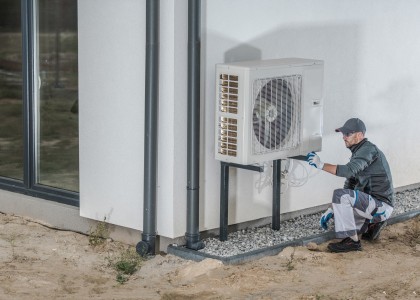Home weatherization can improve people’s health, yet efficiency programs operate nearly in isolation from public health efforts. A new ACEEE report shows how efficiency programs can leverage federal funding focused on health—potentially as much as $2 billion annually—to expand their offerings and serve more people.
“Programs to improve home energy efficiency are in many respects already public health efforts—though we often don’t realize it,” says Sara Hayes, director of ACEEE’s health and environment program and a report co-author. “We focus on utilities and the federal weatherization program to fund efficiency work, but we should also be looking to funding from the health sector.”
Better insulating a home and sealing it from the outdoors can reduce indoor air contaminants and help control moisture and mold. As a result, these improvements can reduce some asthma symptoms and upper respiratory risks. Efficiency measures also reduce exposure to extreme temperatures, which are especially dangerous for infants and older adults. In-home programs can provide complementary services that can help identify and mitigate an even wider range of in-home health threats such as carbon monoxide exposure, fall hazards, respiratory irritants and other asthma triggers, fire risk, radon, lead, and more.
The U.S. Department of Energy funds the Weatherization Assistance Program, contributing to improvements in the health of participants. But funding from other federal agencies aimed at improving public health has generally not been leveraged to support in-home energy efficiency efforts, though several of these federal programs clearly allow funds to be used in this way.
This new ACEEE report identifies six federal programs that could potentially fund in-home energy efficiency efforts.
The State Children’s Health Insurance Program (CHIP), for instance, helps states pay for health care and related costs for many low-income families with children. CHIP already funds in-home health interventions, such as several state programs that reduce lead exposure. An energy efficiency program administrator could work with a state’s CHIP administrator to apply for matching funds.
Medicaid has already been used to fund home efficiency work, though on a small scale. A $10 million pilot program recently announced by New York State Energy Research & Development Authority is anticipated to be fully funded through Medicaid, pointing the way for others.
The Treasury Department’s Social Impact Partnerships to Pay for Results Act grants, the Department of Housing and Urban Development’s Lead Hazard Control Grants, and the Centers for Disease Control and Prevention’s National Asthma Control Program and Preventive Health and Health Service Block Grant round out the funding sources explored in the report.
Using these funding sources is novel and may require action and engagement by programs administrators and state policymakers, but the opportunity is significant. The new ACEEE report aims to help program administrators and advocates “braid” together energy efficiency and health-focused funding sources to provide a wider range of in-home services.
“Braiding these funds is an opportunity for efficiency programs to expand services and reach more people, particularly low-income households, where current funding is far inadequate to meet the needs,” says Hayes. “Embracing the connection between efficiency and improved health will empower program administrators to have even greater impact, and that’s what we want to see.”
Report co-author Christine Gerbode will speak about the new research as part of a Department of Energy-sponsored webinar, “Energy-Efficiency Funding for Residential Programs: Challenges and Opportunities,” on July 23 from 1:00-2:30 pm ET.




